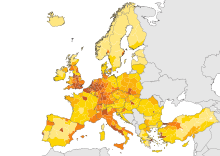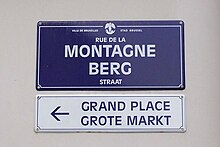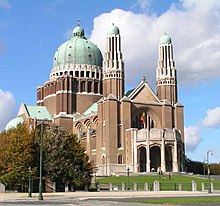| [hide]Climate data for Brussels | |||||||||||||
|---|---|---|---|---|---|---|---|---|---|---|---|---|---|
| Month | Jan | Feb | Mar | Apr | May | Jun | Jul | Aug | Sep | Oct | Nov | Dec | Year |
| Record high °C (°F) | 15.3 (59.5) |
20.0 (68) |
24.2 (75.6) |
28.7 (83.7) |
34.1 (93.4) |
38.8 (101.8) |
37.1 (98.8) |
36.5 (97.7) |
34.9 (94.8) |
27.8 (82) |
20.6 (69.1) |
16.7 (62.1) |
38.8 (101.8) |
| Average high °C (°F) | 5.7 (42.3) |
6.6 (43.9) |
10.4 (50.7) |
14.2 (57.6) |
18.1 (64.6) |
20.6 (69.1) |
23.0 (73.4) |
22.6 (72.7) |
19.0 (66.2) |
14.7 (58.5) |
9.5 (49.1) |
6.1 (43) |
14.2 (57.6) |
| Daily mean °C (°F) | 3.3 (37.9) |
3.7 (38.7) |
6.8 (44.2) |
9.8 (49.6) |
13.6 (56.5) |
16.2 (61.2) |
18.4 (65.1) |
18.0 (64.4) |
14.9 (58.8) |
11.1 (52) |
6.8 (44.2) |
3.9 (39) |
10.54 (50.97) |
| Average low °C (°F) | 0.7 (33.3) |
0.7 (33.3) |
3.1 (37.6) |
5.3 (41.5) |
9.2 (48.6) |
11.9 (53.4) |
14.0 (57.2) |
13.6 (56.5) |
10.9 (51.6) |
7.8 (46) |
4.1 (39.4) |
1.6 (34.9) |
6.9 (44.4) |
| Record low °C (°F) | −21.1 (−6) |
−18.3 (−0.9) |
−13.6 (7.5) |
−5.7 (21.7) |
−2.2 (28) |
0.3 (32.5) |
4.4 (39.9) |
3.9 (39) |
0.0 (32) |
−6.8 (19.8) |
−12.8 (9) |
−17.7 (0.1) |
−21.1 (−6) |
| Average precipitation mm (inches) | 76.1 (2.996) |
63.1 (2.484) |
70.0 (2.756) |
51.3 (2.02) |
66.5 (2.618) |
71.8 (2.827) |
73.5 (2.894) |
79.3 (3.122) |
68.9 (2.713) |
74.5 (2.933) |
76.4 (3.008) |
81.0 (3.189) |
852.4 (33.559) |
| Average precipitation days | 19.2 | 16.3 | 17.8 | 15.9 | 16.2 | 15.0 | 14.3 | 14.5 | 15.7 | 16.6 | 18.8 | 19.3 | 199 |
| Average snowy days | 5.2 | 5.9 | 3.2 | 2.4 | 0 | 0 | 0 | 0 | 0 | 0 | 2.4 | 4.6 | 24.1 |
| Average relative humidity (%) | 86.6 | 82.5 | 78.5 | 72.5 | 73.2 | 74.1 | 74.3 | 75.5 | 80.9 | 84.6 | 88.2 | 88.8 | 80 |
| Mean monthly sunshine hours | 59 | 77 | 114 | 159 | 191 | 188 | 201 | 190 | 143 | 113 | 66 | 45 | 1,546 |
| Source: KMI/IRM[55] | |||||||||||||
Demographics
Population
Population density of Europe, Brussels is located between the largest urban centres
| 01-07-2004[57] | 01-07-2005[57] | 01-07-2006[57] | 01-01-2008[57] | 01-01-2015[57] | |
|---|---|---|---|---|---|
| Brussels-Capital Region[57] | 1.004.239 | 1.012.258 | 1.024.492 | 1.048.491 | 1.181.272 |
| -- of which foreigners[57] | 262.943 | 268.009 | 277.682 | 295.043 | 385.381 |
Nationalities
| Largest groups of foreign residents[58] | |
| Nationality | Population (2016) |
|---|---|
| 62,507 | |
| 38,690 | |
| 38,274 | |
| 32,322 | |
| 28,042 | |
| 26,399 | |
| 19,791 | |
| 11,371 | |
| 10,527 | |
| 8,846 | |
Brussels has a large concentration of immigrants and their children from other countries, including many of Turkish and Moroccan ancestry, together with French-speaking black Africans from the Democratic Republic of the Congo, Rwanda and Burundi.
People of foreign origin make up nearly 70%[59] of the population of Brussels, most of whom have been naturalized following the great 1991 reform of the naturalization process. About 32% of city residents are of non-Belgian European origin, and 36% are of another background, mostly from Morocco, Turkey and Sub-Saharan Africa. Among all major migrant groups from outside the EU, a majority of the permanent residents have acquired Belgian nationality.[60]
Languages
See also: Francization of Brussels
Estimate of languages spoken at home (Capital Region, 2013)[61]
French
Dutch and French
Dutch
French and other language
Neither Dutch nor French
Manneken Pis is a well-known public sculpture in Brussels
Only since the 1960s, after the fixation of the Belgian language border, and after the socio-economic development of Flanders was in full effect, could Dutch stem the tide of increasing French use.[66] Through immigration, a further number of formerly Dutch-speaking municipalities in surrounding Brussels became majority French-speaking in the second half of the 20th century.[67][68][69] This phenomenon is, together with the future of Brussels, one of the most controversial topics in all of Belgian politics.[70][71]
Bilingual signs in Brussels
The original Dutch dialect of Brussels (Brussels) is a form of Brabantic (the variant of Dutch spoken in the ancient Duchy of Brabant) with a significant number of loanwords from French, and still survives among a minority of inhabitants called Brusseleers, many of them quite bi- and multilingual, or educated in French and not writing in Dutch. Brussels and its suburbs have evolved from a Dutch-dialect–speaking town to a mainly French-speaking town. The ethnic and national self-identification of the inhabitants is quite different along ethnic lines.
For their French-speaking Bruxellois, it can vary from Belgian, Francophone Belgian, Bruxellois (like the Memellanders in interwar ethnic censuses in Memel), Walloon (for people who migrated from the Wallonia Region at an adult age); for Flemings living in Brussels it is mainly either Flemish or Brusselaar (Dutch for an inhabitant) and often both. For the Brusseleers, many simply consider themselves as belonging to Brussels. For the many rather recent immigrants from other countries, the identification also includes all the national origins: people tend to call themselves Moroccans or Turks rather than an American-style hyphenated version.
The two largest foreign groups come from two francophone countries: France and Morocco.[77] The first language of roughly half of the inhabitants is not an official one of the Capital Region.[78] Nevertheless, about three out of four residents are Belgian nationals.[79][80][81]
In recent decades, owing to migration and the city's international role, Brussels is home to a growing number of foreign language speakers. In 2013, figures cited in the Marnix Plan show that 63.2% of Brussels inhabitants are native speakers of French, while less than 20% are native Dutch speakers. Just 2.5% speak English as their mother tongue, but 29.7% of people living in the city claim to speak English well or very well.[82] Even though some people want English to be used as an unofficial compromise language between Dutch and French, French remains the lingua franca. And laws still require Dutch and French translations in most cases. The acceptance of English as a language for communication with the city's public servants depends entirely on the knowledge of this language by the public servants, though they must accept questions in French and Dutch.[83]
The migrant communities, as well as rapidly growing communities of EU-nationals from other EU-member states, speak many languages like French, Turkish, Arabic, Berber, Spanish, Italian, Portuguese, Polish, German, and (increasingly) English. The degree of linguistic integration varies widely within each migrant group.
Religions
St. Mary's Royal Church, a 19th-century Roman Catholic church in Brussels
Basilica of the Sacred Heart, Koekelberg
Recognized religions and Laïcité enjoy public funding and school courses: every pupil in an official school from 6 years old to 18 must choose 2 hours per week of compulsory religion – or Laïcité – inspired morals.[citation needed]
Brussels has a large concentration of Muslims, mostly of Turkish and Moroccan ancestry. Belgium does not collect statistics by ethnic background, so exact figures are unknown. It was estimated that in 2005 people of Muslim background living in the Brussels Region numbered 256,220 and accounted for 25.5% of the city's population, a much higher concentration than those of the other regions of Belgium.[84][better source needed]
| Regions of Belgium[84] (1 January 2005) | Total population | People of Muslim origin | % of Muslims |
|---|---|---|---|
| Belgium | 11,371,928 | 781,887 | 6.9% |
| Brussels-Capital Region | 1 180 531 | 306,938 | 25% |
| Wallonia | 3,395,942 | 136,596 | 4.0% |
| Flanders | 6,043,161 | 235,935 | 3.9% |






No comments:
Post a Comment